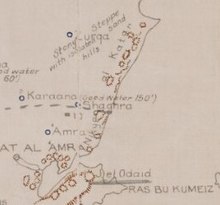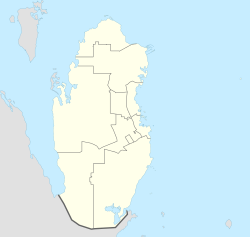Shagra, Qatar
Shagra
شقراء | |
|---|---|
Settlement | |
| Coordinates: 24°49′00″N 51°22′00″E / 24.81667°N 51.36667°E | |
| Country | |
| Municipality | Al Wakrah Municipality |
| Zone | Zone 94 |
| Area | |
• Total | 497.2 km2 (192.0 sq mi) |
| Elevation | 16 m (52 ft) |
| Population (2015) | |
• Total | 4,714 |
| • Density | 9.5/km2 (25/sq mi) |
Shagra (Arabic: شقراء [ALA-LC: Shaqrāʼ]; also known as Ash Shagra and Shaqra) is a Qatari settlement located in the municipality of Al Wakrah.[2] It was previously located in Mesaieed Municipality before the municipality was incorporated in Al Wakrah Municipality.[3]
It is a highly undeveloped area, consisting mainly of open desert. Of its 497.2 square km area, only 46 square km of land is under use. Residential units occupy 2% of its land, commercial and industrial establishments occupy 10%, and "other" (including under-construction) areas account for the remaining 88% of developed land.[4]
Etymology
[edit]Shagra's name has its roots in the Arabic word 'shaqra', meaning 'blonde' or 'fair'. This name was originally given to a well posthumously for a light-colored camel owned by nomads in the area, and eventually came to be applied to the entire region.[5]
Various alternative transliterations of the name are used by the Ministry of Municipality and Environment, including Shaqra, Eshaiqir, and Leshaiger.[5]
Geography
[edit]
The most convenient point of entry into Shagra is from the road leading from Mesaieed to the east. Another route, accessible from the north and west, is from the village of Al Khubayb.[6]
Archaeology
[edit]An important Neolithic period site is located in Shagra.[7] The site was first discovered by a French archaeological team in 1981, and in 1988 it was described in a publication authored by a member of the team, Dr. Marie-Louise Inizan.[8] It is one of the earliest settlements found in the southern portion of Qatar and dates back to 6000 BC. Among the artifacts found at the site was a two-room structure, flints and remnants of fish and molluscs.[9][10]
Although there were numerous references to the site in Inizan's reports, no co-ordinates were mentioned and the site was subsequently lost due to strong winds burying the area under sand.[11] The general location of Shagra was re-discovered in 2008 by a hydrologist named Philip Macumber when he found markers belonging to the French archaeological team. Between 2010 and 2012, Qatar Museums Authority attempted to narrow the location of the site but were unsuccessful. Finally, in 2015, geologist Jacques LeBlanc was successful in rediscovering the site.[11]
In addition to rediscovering the lost site, LeBlanc also discovered a new site approximately 0.65 kilometres (0.40 mi) northwest of the old site which he dubbed Shagra II. At the site, he recorded an 18 meter path along which foundations were visible of four to five adjacent dwellings, a lone dwelling roughly 19 meters south of the aforementioned path, another partially submerged dwelling approximately 13 meters northeast of the path, and a north-to-south facing grave 5 meters to the west from the path. The grave is located in a sabkha, has rock slabs on either side, and may have belonged to a child.[12]
Demographics
[edit]As of the 2010 census, the settlement comprised 11 housing units[13] and 6 establishments.[14] There were 3,874 people living in the settlement, of which 99% were male and 1% were female. Out of the 3,874 inhabitants, 99% were 20 years of age or older and 1% was under the age of 20. The literacy rate stood at 97.6%.[15]
Employed persons made up 100% of the total population. Females accounted for 0% of the working population, while males accounted for 100% of the working population.[15]
| Year | Population |
|---|---|
| 1986[16] | 33 |
| 1997[17] | 33 |
| 2004[3] | 54 |
| 2010[18] | 3,874 |
| 2015[2] | 4,714 |
References
[edit]- ^ "Shagra, Zone 94, Qatar on the Elevation Map". elevationmap.net. Retrieved 14 January 2019.
- ^ a b "2015 Population census" (PDF). Ministry of Development Planning and Statistics. April 2015. Retrieved 8 August 2017.
- ^ a b "2004 population census". Qatar Statistics Authority. Retrieved 2 July 2015.
- ^ "Broad Land Use Categories by Zone 2015". Ministry of Development Planning and Statistics. Retrieved 27 August 2018.
- ^ a b "District map". The Centre for Geographic Information Systems of Qatar. Retrieved 24 February 2019.
- ^ Phillip G Macumber (2012). "An examination of the impact of environmental disparity on the occupation of Qatar". University of Copenhagen. p. 24. Retrieved 5 July 2018.
- ^ Abdul Nayeem, Muhammad (1998). Qatar Prehistory and Protohistory from the Most Ancient Times (Ca. 1,000,000 to End of B.C. Era). Hyderabad Publishers. p. 20. ISBN 9788185492049.
- ^ Jacques LeBlanc (25 July 2015). "The new "Al-Shagra II" Site (Qatar)". p. 1, 5, 9. Retrieved 1 August 2017.
- ^ Casey, Paula; Vine, Peter (1991). The heritage of Qatar (print ed.). Immel Publishing. p. 11. ISBN 978-0907151500.
- ^ Andrew Peterson (2010). "Islamic Period Qatar" (PDF). Minerva. Retrieved 2 July 2015.
- ^ a b Jacques LeBlanc (August 2015). "The Al-Shagra archeological site re-discovered (Qatar)". p. 1. Retrieved 1 August 2017.
- ^ LeBlanc, Jacques (25 July 2015). "The new " Al-Shagra II " Site (Qatar)". p. 5. Retrieved 24 February 2019.
- ^ "Housing units, by type of unit and zone (April 2010)" (PDF). Qatar Statistics Authority. Retrieved 9 August 2015.
- ^ "Establishments by status of establishment and zone (April 2010)" (PDF). Qatar Statistics Authority. Retrieved 9 August 2015.
- ^ a b "Geo Statistics Application". Ministry of Development Planning and Statistics. Archived from the original on 11 September 2012. Retrieved 9 August 2015.
- ^ "1986 population census" (PDF). Qatar Statistics Authority. Archived from the original (PDF) on 3 July 2015. Retrieved 2 July 2015.
- ^ "1997 population census" (PDF). Qatar Statistics Authority. Archived from the original (PDF) on 29 May 2015. Retrieved 2 July 2015.
- ^ "2010 population census" (PDF). Qatar Statistics Authority. Retrieved 2 July 2015.

